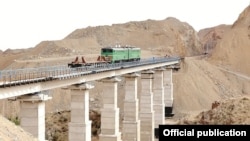There are new steel threads on the old Silk Road.
RFE/RL's Tajik Service, known locally as Ozodi, just reported that Uzbekistan has completed construction of the Angren-Pap railway line. It's quite a feat for Uzbekistan, especially as it was built much faster than original estimates. But it is symbolically also a sad reminder of the direction in which the five Central Asian states are heading.
The Angren-Pap connects the Tashkent area with Uzbekistan's eastern Ferghana Valley region. The line is 123.1 kilometers long; some 2,100 meters of new bridges were constructed and two tunnels, one of which is 19.1 kilometers long, were built. The project cost some $1.9 billion, some of which came from loans from the World Bank and Islamic Bank of Reconstruction and Development.
The reason for building the line? So Uzbek trains no longer need to transit through Tajikistan.
The governments of Uzbekistan and Tajikistan -- or more specifically the presidents of Uzbekistan and Tajikistan -- are not on good terms and haven't been for about 20 years.
The borders established during Soviet times left a spur of Tajikistan jutting up into Uzbekistan, partially dividing Uzbekistan's section of the Ferghana Valley from the rest of the country. During the Soviet days, the train between Margilan, in eastern Uzbekistan, and Tashkent went by way of Khujand, Tajikistan.
This line continued running after the collapse of the Soviet Union. That is how I usually traveled between the Uzbek capital and Ferghana Valley in 1992. Gradually, passenger trains have been phased out.
RFE/RL's Tajik Service spoke with Tolibboy Ashurov, a representative of Tajikistan's Sughd region, where Khujand is located, who said that even cargo trains have reduced service. In the past, "up to 4 million tons [of cargo] a year" of Uzbek freight passed through Sughd region, Ashurov said. "The transit of Uzbek goods brought some $28 million annually to Tajikistan's state coffers, but in recent years the volume of transit has dropped sharply," he added.
The new railway clearly benefits Uzbekistan. But conversely, it puts Tajikistan in a horrible situation. For one thing, Angren-Pap removes one of the few aspects of Uzbek-Tajik relations that really required some level of cooperation between the two governments since Uzbekistan needed the old line through Tajikistan to ship goods. Without this small bargaining chip, Dushanbe has no leverage to convince Tashkent to allow trains to reach Tajikistan, and all trains to or from Tajikistan must pass through Uzbekistan's territory.
That's already been a problem, for instance when Tajikistan was having construction material shipped by rail for use in building hydropower plants (HPPs). Tashkent objects to Tajikistan building HPPs on rivers that flow into Uzbekistan. Uzbek customs officials stopped and searched trains bound for Tajikistan; those with construction materials were turned back. These delays in railway traffic through Uzbekistan also led to food and fuel shortages in Tajikistan.
Sign Of The Times
So one could view the Angren-Pap line as an example of a failure of the Uzbek and Tajik governments to reach some agreement that could have kept the old line working smoothly and saved Uzbekistan nearly $2 billion. It stings a little worse realizing Uzbekistan originally planned for the project to take five years to complete but Tashkent pressed for the railway line to be completed faster and in the end it took just a bit more than two years.
This situation cannot be blamed solely on Uzbekistan. It is a failure that other Central Asian governments share. Tajikistan started construction of its own railway to bypass Uzbekistan in 2008. Turkmenistan completed a new line in 2011 that was built to bypass Uzbek territory but that was after Uzbekistan constructed a new railway to avoid Turkmen territory in 2009.
Kazakhstan, Turkmenistan, and Iran just launched a railway (North-South Transport Corridor) linking the three countries in December 2014. But that is the only railway line built in post-Soviet Central Asia that actually connects two Central Asian countries. All the other railways built since late 1991 were built to other countries (Kazakhstan-China, Turkmenistan-Iran, and Uzbekistan-Afghanistan) or to avoid having to transit a neighbor's territory.
It says something about relations between the five Central Asian countries.











